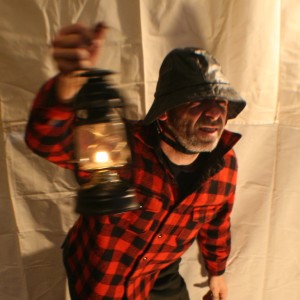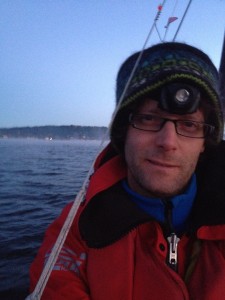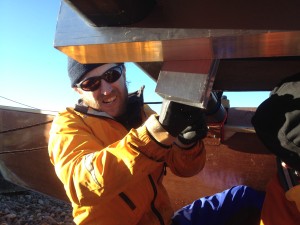Polynesian Vikings meet the Patagonian Chonkeh
Ivan Doig’s “The Sea Runners” has four hapless Scandinavians escape from Russian Alaska by stolen native canoe. We’re taking it back in half the time, with half the crew and twice the boat. When you spend your Tuesday nights holed up in the halau wa’a dreaming up new marine disasters, some crazy synergy happens. The outcome is excitement, flying sawdust and the odd bridge jumping into deep cold and dark waters. When you mix in the Pyrat, you enter the R2AK. Bring in an oceanographer who is fluent in Orca and can read the signs of the Inside Passage’s notorious slow water, and a man who once taught a boat building class called “jazz sailing and jungle boat building” to an astounded group of talent, and have them consult with one of Hawaii’s premier experts on the old Hawaiian ways of the Pacific Swirl and an ex-US Cycling Team Member who got into pedal boats and can crank out a sustained 300+ watts, and you have a focused mix that throws out all the preconceptions. As Thomas recently proclaimed, “we’ve been deep in R&D and training for this race for the last four years — way before they even know they were going to hold it!”
That was our registration description for Team Sea Runners when we first took form to tack through the 2015 Race Towards Alaska. The inaugural two racers were Thomas Nielsen and Scott Veirs. We were assisted by many family members, friends, boat builders, designers, advisors, and sponsors. Below you’ll find the “Relevant Experience” CVs we submitted with our race registration, along with information about our community.
In 2015, we made it to Telegraph Cove on the north end of Vancouver Island after two weeks of mostly upwind effort. Thomas returned as a solo version of Team Sea Runner(s) in the 2016 Race to Alaska (R2AK) and finished in a Seascape 18. In 2016-2018, Team Sea Runners returned some engineering advice and pedal drive field experience to Matt Johnson who competed in the R2AK each year (taking 2nd place in stage 1 in 2017).
In 2018, at the urging of 2015 R2AK advisor Kevin Flick, Team Sea Runners re-formed for the first Seventy48 human-powered (no sails!) race from Tacoma to Port Townsend. With the rig and one tramp removed so we could paddle on both sides of the starboard hull while pedaling on the recumbent station shifted to port, Team Sea Runners ran through the night and finished in 32nd place, maintaining an average speed of 5.85 km/hr (3.16 knots). We kept moving for 19 hours and 10 minutes, stopping only to replace the three props we lost.
In August, 2018, Team Sea Runners participated in the first Barefoot Raid — a 7-day 12-leg race organized by Barefoot Wooden Boats (Quill Goldman). Scott was assisted for the first few days by 12-year-old Cora Reese, and through a combination of the Rick Willoughby-designed pedal drive and the 2015 crab claw sails on a new A-frame mast managed to win 4th place overall.
Thanks to all who have supported us and the causes for which race!
 Thomas Nielsen
Thomas Nielsen
Focused driven adventurer always with one bag packed and ready to go. The coast and seas westward to the Hawaiian Islands from Bristol Bay to San Francisco are a familiar sailing, mountaineering, kayaking and working backyard. 25 plus years of climbs have taken me up the lower 48 coastal peaks, to Vancouver Island heights, in the back country of Whistler – Squamish corridor, and to wait out BC and AK storms on Waddington, Alverstone, Kennedy and Hubbard to mention a few. Kayaking includes a summer run down from Skagway to Seattle with a paddle made from stuff from Dunn Lumber. $400 to your name is a lot if you never spend any of it along the way. Sailing has been an ongoing lifetime venture with the first crossing a family affair at age four. Saltwater is my blood. Trips up the inside passage, around Vancouver Island several times and on the Salish Sea are my lifeline. A mad ride on a 38′ Polynesian style catamaran with white poly tarp sails on a crab claw rig from Sausalito to Hilo in 13 days proved you don’t need Dacron and you don’t need diesel – you just need to go! Other sailing adventures have taken me to the Great Lakes, the Atlantic from Newfoundland to up to the Caribbean and the North Sea and Baltic. Memorable trips include 24 hr full tilt runs around Mount Rainier, bushwhacking the west coast of Vancouver Island from North of Estevan Point to Friendly Cove building rafts along the way to cross whatever water got in the way. Boatbuilding is an addiction including one on the top of a VW van while climbing in the Four Corners and one on the deck of a live-a-board Westsail 28 in Eagle Harbor. And once upon a time there was a career as a Canadian Coast Guard SAR officer that piloted CCG hovercraft (definitely not HPV) out of Vancouver Airport amongst other Canadian Coast Guard type duties such as busting ice, patching up people who needed first aid, deliver babies, find the lost, mopping up oil, placing buoys and making sure remote Arctic community members got their fair share.
 Scott Veirs
Scott Veirs
Intermittent adventurer, family cruiser, boat-building oceanographer. Adventure background includes climbing (east buttress of El Cap, Ptarmigan Ridge Mt. Rainier, north ridge Mount Stuart, guiding beginners up Mt. Baker Easton Glacier, and the Ptarmigan traverse with teenagers), white water kayaking (class 3-5 in CA, OR, WA), sailing (overnight crossing of Sea of Cortez, 6 weeks on a 130′ schooner in Gulf of Maine and off Nova Scotia), and a Wilderness First Aid Responder certification. Cruising/sailing experience started with tiny boats in Colorado reservoirs, windsurfing in CA, then Lasers and Hobies in grad school (taught with UW Yacht Club), ownership of a Nacra 5.2, 10s of trips in the San Juans aboard a 42′ cat teaching sailing and marine science, and in last 5 years many overnights on Lake WA or in Puget Sound and annual week-long summer cruises in the Salish Sea (San Juans, Gulf Islands, Desolation Sound) aboard a home-built Wharram Tiki 21 catamaran. In addition to building the Tiki 21, my home workshop has hosted: a build of a skin-on-frame boat aiming to break the human-powered world record for distance on flat water in 24 hours; maintenance of a Wharram Tiki 26 and Pahi 26; and restoration of a Babson 15′ and a Boston Whaler Harpoon 4.6. PhD in oceangraphy from the University of Washington (3 cruises of 15-30 days off the coast of BC and WA, 1 dive to study hydrothermal vents at 2200 meters depth in the submersible Alvin) and 10 years teaching or conducting marine research, along with extensive SCUBA diving for pleasure or hydrophone maintenance, has given me deep insights into the currents, weather, and other natural phenomena that govern the sailor’s experience in the Northeast Pacific.
 2015 R2AK advisors and supporters
2015 R2AK advisors and supporters
- James Wharram & Hanneke Boon — James Wharram Designs
- Kiko Johnston-Kitazawa — Captain of Wa’akaulua Sailing Excursions, Hawaii
- Matt Johnson — Pedal power and boat design advisor
- Dr. Kevin Flick — Survival challenger and equipment consultant
- Sven Haakanson — Curator of Native American anthropology at the Burke Museum
- Erich Hvalsoe — Boats Hvalsoe
- Tim King — Pedal power guru
- Lise Glaser — Paddle power guide
- Dr. Annie Reese — Medicine woman
- Michael Dougherty — Electronics and innovation
- Stefan Hampden — Structural integrity
- George Adair — Local wisdom